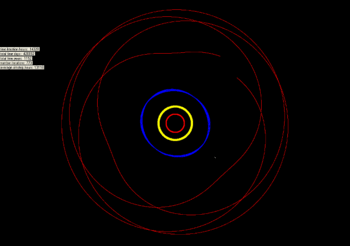(48639) 1995 TL8
| Discovery | |
|---|---|
| Discovered by | A. Gleason (Spacewatch) |
| Discovery date |
15 October 1995 and 9 November 2002 (moon) |
| Designations | |
| MPC designation | (48639) 1995 TL8 |
| none | |
| Classical (DES)[1] | |
| Orbital characteristics [2] | |
| Epoch 30 November 2008 (JD 2454800.5) | |
| Aphelion |
65.086 AU 9,736 Gm (Q) |
| Perihelion |
39.980 AU 5,980 Gm (q) |
|
52.533 AU 7,858 Gm (a) | |
| Eccentricity | 0.23894 |
| 380.77 a (139077 d) | |
Average orbital speed | 4.06 km/s |
| 35.705° | |
| Inclination | 0.24686° |
| 260.30° | |
| 84.104° | |
| Known satellites | 1 |
| Physical characteristics | |
| Dimensions |
≈ 350 (primary) and ≈160 km (secondary) |
| Albedo | 0.09 (assumed) |
| Temperature | ≈ 38 K |
| 5.28 and 6.98 | |
|
| |
(48639) 1995 TL8 (also written (48639) 1995 TL8) is a classical Kuiper belt object possessing a relatively large satellite.
The assumed diameter of 352 kilometres (219 mi) is derived from an albedo guess of 0.09, being typical for trans-Neptunian objects.[3]
Discovery
Discovered in 1995 by Arianna Gleason as part of the Spacewatch project, it was the first of the bodies presently classified as a scattered-disc object (SDO) to be discovered, preceding the SDO prototype (15874) 1996 TL66 by almost a year.
Satellite
A companion was discovered by Denise C. Stephens and Keith S. Noll, from observations with the Hubble Space Telescope taken on 9 November 2002, and announced on 5 October 2005. The satellite, designated S/2002 (48639) 1, is relatively large, having a likely mass of about 10% of the primary. Its orbit has not been determined, but it was at a separation of only about 420 kilometres (260 mi) to the primary at the time of discovery, with a possible orbital period of about half a day and an estimated diameter of 161 kilometres (100 mi).[4]
Scattered–extended object
(48639) 1995 TL8 is classified as scattered–extended by the Deep Ecliptic Survey (DES), since its orbit appears to be beyond significant gravitational interactions with Neptune's current orbit.[1] However, if Neptune migrated outward, there would have been a period when Neptune had a higher eccentricity.
Simulations by Emel’yanenko and Kiseleva in 2007 show that (48639) 1995 TL8 appears to have less than a 1% chance of being in a 3:7 resonance with Neptune, but it does execute circulations near this resonance.[5]
It has been observed 48 times and has an orbit quality code of 4 (0 being best; 9 being worst).[2]

See also
- 3753 Cruithne (orbital circulations due to near resonant perturbations with Earth)
- (131696) 2001 XT254 - to see a proper 3:7 resonance with Neptune
References
- 1 2 Marc W. Buie (2003-10-22). "Orbit Fit and Astrometric record for 48639". SwRI (Space Science Department). Retrieved 2009-01-26.
- 1 2 "JPL Small-Body Database Browser: 48639 (1995 TL8)" (last obs). 2008-08-29. Retrieved 2009-01-26.
- ↑ Wm. Robert Johnston (22 August 2008). "List of Known Trans-Neptunian Objects". Johnston's Archive. Archived from the original on 13 February 2009. Retrieved 2009-01-26.
- ↑ Wm. Robert Johnston (2005-10-09). "(48639) 1995 TL8". Johnston's Archive. Archived from the original on 10 December 2005. Retrieved 2006-02-07.
- ↑ Emel’yanenko, V. V; Kiseleva, E. L. (2008). "Resonant motion of trans-Neptunian objects in high-eccentricity orbits". Astronomy Letters 34 (4): 271–279. Bibcode:2008AstL...34..271E. doi:10.1134/S1063773708040075.
External links
- Orbital simulation from JPL (Java) / Horizons Ephemeris
- 1999 MPEC listing
- 2000 MPEC listing
- IAU minor planet lists
| ||||||
| ||||||||||||||
| ||||||||||||||||||||||||||||



